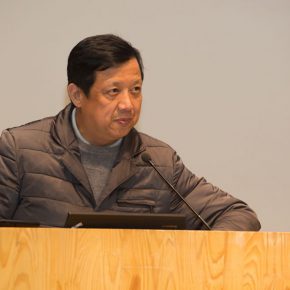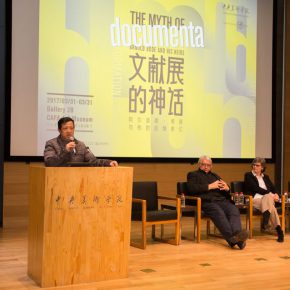
At 18:00 on March 2, 2017, CAFA Art Museum launched a lecture entitled “documenta – die Weltausstellung zeitgenössischer Kunst”, and the honored guests included Heinrich Georgsdorf, former assistant to the founder of documenta Arnold Bode, Annette Kulenkampff, President of the Documenta Public Limited Liability Company; Prof. Dr. Klaus Siebenhaar, President of Freie Universität Berlin and a professor, as well as the German curator of “The Myth of documenta”; Yu Ding, Chinese curator of “The Myth of documenta” and Dean of the Institute of Arts Administration and Education at CAFA hosted the lecture, and Wang Wenting from the Institute of Arts Administration and Education at CAFA served as the translator.
Art: Arnold Bode and documenta in the MemoryHeinrich Georgsdorf is the former assistant to Arnold Boulder. During his lecture, through the use of photos he recalled the experiences of his work with Bode and information on Bode who he came into contact with.
In the eyes of Heinrich Georgsdorf, Bode was a “person dedicated to contemporary art, but he was also very enthusiastic about classical art. For Bode, there is no difference between ancient and modern art, there is only good or bad art, instead of the differences of time and region. Heinrich Georgsdorf recalled Bode’s love and protection of non-modern art after the end of World War II. At that time, Rembrandt’s “Jacob’s Prayer” was on display at the Kassel Art Museum, Arnold Bode personally designed the representation, and Bode even placed Lascaux’s frescoes in a contemporary exhibition, he hoped that people would recognise the association between contemporary art and the house of primitive art.
“Like many artists at that time, Bode followed the trend of modernism, but it was suppressed during the Nazi era and the art was slandered. In 1955, Bode hoped that an exhibition would tell the masses that the artists who were slandered by Nazism were not decadent artists.” This was the original intention in holding documenta, in order to rebuild and restore the city of Kassel and modernist art thus documenta was born and has been held 13 times so far, soon we are going to welcome the 14th session.
In memory of the exhibition itself, Heinrich Georgsdorf said: “documenta 1 gave shocked me because the material submitted for the exhibition was not the exhibition material that people could imagine: Bode used a lot of cheap plastic curtains in the exhibition, because he had worked in this company, he could get materials at a very low price, while this material was quite modern at the time. It was obvious that Bode’s spatial design of documenta 2 referred to the Japanese tea room, a classmate had visited Japan with a black and white camera, so that we saw the Japanese tea room was black and white thus the exhibition was also black and white. In the documenta 3, the presentation design of the works of Ernst Wilhelm Nay were the summative works for Arnold Bode, it was a Baroque exhibition form with a modern context, which was reminiscent of the castles and churches of the Baroque period, and people had to look up to the frescoes on the ceiling.”
Operating Mechanism: Documenta Public Limited Liability CompanyDocumenta Public Limited Liability Company is a unique operating mechanism of documenta. First of all, Annette Kulenkampff, President of the Documenta Public Limited Liability Company introduced the company’s overall profile: “We take the form of a limited liability company, but it is not for profit. Kassel and Hessen are the two partners of the company, each undertaking a 50% stake.”
In addition to the funds provided by the partners, 50% of the cost of the documenta must be raised by itself through ticket sales, albums and other publications, as well as advertisements, and this is applied to the artist’s creative costs. Annette Kulenkampff believed that along with the emergence of an increasingly visible trend in globalization, it meant that the curatorial team had to look for artists around the world, which greatly enhanced the operating costs and difficulties.
As for the team of the exhibition, Annette Kulenkampff introduced that: “Every session of documenta started from an art director which then expanded to 700 staff for the opening of the documenta, and the 700 people are all managed and hired by Documenta Public Limited Liability Company. After the end of the documenta, 700 employees disappeared, and the company starts from zero again, looking for a new art director, new exhibition locations, while the only constant location is the Fridericianum.”
Annette Kulenkampff believed that although the documenta has continuously expanded over the 60 years, Kassel was a small city, and Documenta Public Limited Liability Company only had a small team, although the management was more and more difficult, experiencing a variety of troubles and changes, it still took a unique operating mechanism and team writing to ensure the stability and development of the documenta.
Research: Public Education of documenta and the AudiencesProf. Dr. Klaus Siebenhaar, German curator of “The Myth of documenta” started from the research perspective of the audience and public education to have a discussion on the documenta. Prof. Siebenhaar first introduced the educational idea of the founder of the exhibition Arnold Bode and said that “Arnold Bode himself was an excellent art communicator, a genius of spatial arrangement. Bode believed that, it was feasible, through spatial arrangement, to create a visual understanding, when the audience entered the space he/she could feel and understand the art, instead of using the guide. Curating means to create a space and context, where the audience and art are exchanged and integrated with art education.”
In the study of the public education of documenta, Prof. Siebenhaar found that in the art educational part of the documenta, it was more “radical” in the early stages, that art and education were blended which is like the ideas from Bode. From the beginning of the 1970s, education returned to “tradition”, and many educational theories, educators emerged, Prof. Siebenhaar thought it was “education of art circles”. Since the 1990s, art education has gradually developed to a service, and if an organization does not offer the service, it seems to be impossible to gain a foothold. He said that, “This over-educated education has an anti-trend in the documenta 12 and documenta 13, which supported a more ‘radical’ educational system and was the educational function of the art itself.”
As for the study of the audience of the documenta, he said that the audiences belonged to the so-called “educated” classes, who visited the museum with smart clothing, dressing in western dress and leather shoes, which was different from today’s audiences. But as early as the documenta 2, people began to relax when visiting the show. In the documenta 4, the art became the field of feeling and experience, which is like a festival, the visitors who visited the documenta in 1968 were called the “self-fulfilling generation” and they could design their own routes and never dress up to visit the documenta.
Therefore, Prof. Siebenhaar believed that the concept of “self-expression” of the audience had been proposed over a long time. The audience would like to take a photo of him by himself when he visited the documenta 13, so that the visiting exhibition has become a self-performance. In addition, there are gradually more and more audiences due to globalization, while Chinese artists entered the documenta in the context of globalization, so documenta has become an event.
Three guest speakers delivered speeches and discussed issues from different perspectives, which did not only help the audience understand “The Myth of documenta – Arnold Bode and His Heirs”, but also broadened and deepened the audience’s understanding of documenta and Arnold Bode. At the end of the lecture, the audience interacted with the three guests from the perspective of spatial design of the exhibition, documenta’s operation and Bode himself.
Text by Zhong Yuwei, Photo by Hu Sichen/CAFA ART INFO
Translated by Chen Peihua and edited by Sue/CAFA ART INFO




































